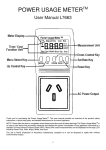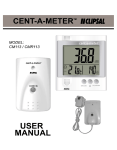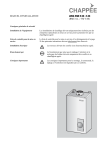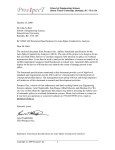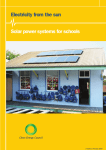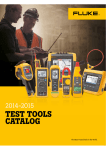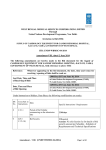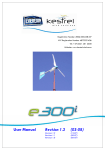Download Focus on Energy Reduction
Transcript
FOCUS on Energy Reduction This household energy assessment booklet will help you to identify practical ways to reduce energy consumption by making simple changes to how you use electricity at home. Australians are the biggest greenhouse gas emitters of the developed world. Every year the average Australian household produces 14 tonnes of greenhouse gases. 66% of household greenhouse gas emissions are a result of electricity use within the home1. You can save several tonnes of greenhouse gas emissions through simple changes, reducing your impact on climate change and saving money. Using the Power Meter to conduct your household energy assessment The Power Usage Meter, when plugged into each appliance, measures their energy consumption. You can use this Energy Reduction Kit to; • Measure the amount of energy you currently use; • Compare the electricity ‘thirst’ of various appliances at home to help you identify where you might be able to make the biggest savings; • Determine the cost of energy used to run each appliance over time; and • Determine the greenhouse gas emissions of your appliances. Sometimes it will be difficult to use the Power Usage Meter to measure your consumption (e.g. water heating systems, stove tops and ovens), so standard energy consumption information has been provided on page XX. Once you know how much each appliance costs to run, you can change how you use each appliance, potentially saving your household hundreds of dollars per year. Most household energy assessments take an hour to complete, however it may take time for the Power Usage Meter to accumulate enough data to make a calculation so don’t be surprised if the initial total cost displayed is 0.00. The longer that an appliance is attached to the meter, the more accurate the calculation becomes. This is especially true for appliances that cycle on and off such as refrigerators and televisions. For example if a television is used 4 hours a day, it is important to also measure the 20 hours a day that the television is not in use in order to get an accurate projection of its running costs over a year. Page 1 of 17 WARNING: IMPORTANT SAFETY INFORMATION • • • • • Take care near any electrical or gas appliance Always turn off power points before plugging in or unplugging appliances. Children under 16yrs must be supervised when using the Power Usage Meter To reduce the risk of fire or electrical shock, do not expose this appliance to water or moisture Never insert foreign objects into to Power Usage Meter. How to use the Power Usage Meter2 The following instructions are supplied by Solar Inverters and are a direct copy of the User Manual supplied for the Power Usage Meter L7663 1. Connect the Power Usage Meter to a power outlet. 2. Connect the appliance to be measured/monitored to the Power Usage Meter (just like using a double adapter). 3. Press and hold the RESET key on the unit until ‘rESt’ appears. 4. Press and hold the SET rate button unit ‘Rate’ is displayed. The kWh billing rate flashes in the display. Press UP and DOWN buttons to change the rate. For example; if the Electricity Company charges 27.5 cents per kWh then set the ‘Rate’ at $0.275. 5. Press the SET key again and ‘SAVE’ will appear briefly in the display. 6. To display the actual or projected cost of power consumed; press the MENU key until ‘Cost’ is displayed. 7. Pressing the UP and DOWN buttons will cycle through the cost projection periods. For example; if the display indicates $37. and “Year”, then the unit is projecting that the attached appliance will consume $37 worth of electricity in one year. 8. To display power measurements press the MENU key until ‘VOLT’ is displayed. 9. Pressing the UP and DOWN buttons will display the various measurements made by the meter, choose ‘WATTS’. 10. To display the accumulated measurement totals, press the MENU key until the desired unit to be viewed is displayed. The available units include the accumulated running cost of the attached appliance, KWh rate, total KWh consumed and the elapsed time that the Power Usage Meter has been operating. 11. Once you have recorded your appliance press and hold the RESET button until ‘rESt’ is momentarily displayed. This confirms that all previous measurements including the total accumulated KWh elapsed time and cost measurement have been reset to zero. 7 easy steps to assessing your electricity use at home 1. Carefully read the above instructions on how to use the Power Usage Meter. 2. Choose the appliances you will measure (use the enclosed ‘Home Energy Assessment’ as a guide pg XX). 3. Refer to your last energy bill to find out your cost of electricity or see examples provided by Energy Australia on pg XX. Some electricity providers charge two or more rates depending on consumption, time of day, Page 2 of 17 or the season. The Power Usage Meter determines cost calculations using just a single kWh rate. 4. Plug the Power Usage Meter into the wall socket, then plug the appliance into the Power Usage Meter, see figure XX. 5. Record the ‘Watts’ and ‘Cost Per Year’ on the following table. 6. Estimate how often you use the appliance per week and for how long, and then check to see how you compare to the typical use for that appliance. 7. Read the supplementary information to see how you can improve your energy use, save money and reduce greenhouse gas emissions. Home Energy Assessment How to work out your Green House Gas Emissions 1000 watts = 1 Kilowatt Hour (kWh) Eg 800 watts / 1000 = 0.8 kWh 1kWh of electricity = 1 kilogram of Greenhouse Gas Emissions If you purchase GreenPower you can reduce this figure (eg if you purchase 10% GreenPower reduce your total by 10% etc.) Understanding your appliance running costs Appliance Input wattage (kW) x Cost of 1 kW If you have an electric heater that uses 800W of electricity and your energy retailer tariff is 27.5c per kW, then the hourly running cost is; Heater Wattage kW = 800W divided by 1000 = 0.8kW = 0.8kW x 27.5c = 22c per hour The cost of electricity It is best to contact your electricity supplier or refer to your last bill to establish your electricity costs. Below are examples costs from Energy Australia effective from 1 July 2008. Domestic All Time First 1,750 KWh per quarter * Remaining usage per quarter Cents per kWh 13.9700 cents 20.8450 cents PowerSmart Home with a Time of Cents per Use Meter Installed kWh Peak: 2pm – 8pm on working 30.2500 cents weekdays Shoulder: 7am – 2pm and 8pm-10pm working weekdays and 7am-10pm on 10.8900 cents weekends and public holidays Off peak: all other times 6.0500 cents ** All calculations based on using Energy Australia rates effective from 1 July 2008 Page 3 of 17 Refrigeration Your Appliance Appliance Watts Cost per year Small / Medium Fridge Freezer Frost Free Large Fridge Freezer Frost Free Large Fridge Freezer side by side Small bar fridge Chest Freezer Medium Upright Freezer Kitchen Appliances Appliance Your Appliance Watts Cost Per Year Electric Fry Pan Juicer Kettle Microwave Oven Rice Cooker Toaster Toasted Sandwich Maker Cappuccino Maker Coffee Percolator (10-12 cup) Blender Electric Wok Typical Appliance Annual Emissions Cost per Energy Use (kg /per year (kWh) year) 508 $71.03 539 769 $107.39 815 942 $131.63 999 334 $46.66 354 535 $74.72 567 629 $87.85 667 Typical Appliances Typical Power (watts) Avg Hours per week Annual Energy Use (kWh) Cost per year Emissions (kg /per year) 1700 300 2400 1000 700 1000 1100 1260 1000 600 2000 3 1 1.5 2.5 .75 1.3 .5 1.2 1.2 1 1 265 16 187 130 27 68 29 79 62 31 104 $37.05 $2.18 $26.15 18.16 $3.81 $9.44 $4.00 $10.98 $8.72 $4.32 $14.53 281 17 198 138 29 72 30 83 66 33 110 Electric Cooking Appliance Electric Cook top (all 4 burners operating) Electric Cook top (2 burners operating) Dishwasher (hot wash using cold tap connection 3 star) Electric Oven Bathroom & Laundry Appliance Clothes Dryer Washing Machine Top Load Washing Machine Front Load Hairdryer Heated Towel Rack Iron Vacuum Cleaner Four bulb heat / light / fan Two bulb heat/light/fan Typical Power (watts) Avg Hours per week Annual Energy Use (kWh) Cost per year Emissions (kg /per year) 6000 10 3120 $435.86 3307 3000 10 1560 $217.93 1654 2200 7 801 $111.87 849 2400 3.5 437 $61.02 463 Your Appliance Watts Cost per year Typical Appliance Typical Power (watts) Avg Hours per week 2400 1100 900 1000 100 1000 1200 1200 650 3.5 3.5 3.5 1.5 3.5 1.5 1 14 14 Page 4 of 17 Annual Energy Use (kWh) 437 200 164 78 164 78 62 874 473 Cost per year Emissions (kg /per year) $61.02 $27.97 $22.88 $10.90 $22.88 $10.90 $8.72 $122.04 $66.11 463 212 174 83 174 83 66 926 502 Living Room Appliance Your Appliance Watts Cost per year 34cm Standard TV Flat Screen 76cm LCD 101cm Plasma 107cm Rear Projection TV DVD Player Games Console Stereo System Bedroom & Study Appliance 70 250 225 310 190 50 200 70 Your appliance Watts Cost per year Desktop Computer Laptop Computer Printer Clock Radio Electric Blanket Heating & Cooling Typical Power (watts) Typical Power (watts) 150 20 17 6 120 Typical Appliance Annual Avg Cost per Energy Hours year Use per week (kWh) 38 138 $19.32 38 494 $69 38 445 $62.11 38 613 $85.57 38 375 $52.45 15 39 $5.45 10 104 $14.53 7 25 $3.56 Typical Appliance Annual Avg Cost per Energy Hours year Use per week (kWh) 28 218 $30.51 28 29 $4.05 14 12 $1.73 168 52 $7.32 14 87 $12.20 Typical Appliance Annual Typical Avg Cost per Energy Cost per Appliance Watts Power Hours year year Use (watts) per week (kWh) Portable Evaporative Cooler 103 28 50 $6.98 Portable Oscillating Fan 50 14 12 $1.69 Reverse Cycle Air Conditioner 2800 56 2718 $379.69 Small Electric Bar Heater 750 42 546 $76.28 Large Electric Bar Heater 1000 42 728 $101.70 Electric Fan convection heater 2400 42 1747 $244.08 Large Oil Bar Heater 2400 42 1747 $244.08 As these appliances are seasonal these calculations are based on each appliance being in use for 4 months during the year Outdoor and Garage Appliance Electric Drill Chainsaw Electric Saw Swimming Pool Pump Electric BBQ Outdoor Spa Emissions (kg /per year) 147 524 471 649 398 41 110 27 Emissions (kg /per year) 232 31 13 56 93 Your appliance Your appliance Watts Cost per year Typical Power (watts) 700 1800 1000 1130 2400 6000 Page 5 of 17 Typical Appliance Annual Avg Energy Cost per Hours year Use per week (kWh) 1 36 $5.09 1 94 $13.08 1 52 $7.26 42 2468 $344.77 7 874 $122.04 3 936 $130.76 Emissions (kg /per year) 53 13 2881 578 772 1852 1852 Emissions (kg /per year) 39 99 55 2616 929 992 How is energy consumed in the home? Water and home heating or cooling account for about 60% of an average household’s energy use3. Electric hot water systems are still the most common type in Australian homes they account for around 37% of your power bill. Appliances 4% Other 3% Laundry 5% Lights 6% Hot Water 37% Kitchen 10% Fridge 12% Heating & Cooling 23% Source Energy Australia 3 Hot Water Systems You won’t be able to measure your hot water system using your Power Usage Meter but by reducing your usage you could save up to $400 and prevent 5 tonnes of greenhouse gas emissions per year. Alternatives to electric hot water systems include natural gas hot water which consume less energy and produce 1.5 tonnes costing over $100 per year 5. Solar hot water systems are the most environmentally friendly, providing savings of $300-$700 per year. The bathroom is where the majority of hot water is used in the home and is where the biggest savings can be made. Page 6 of 17 Hot Water in the Home Kitchen, 10% Laundry, 15% Bathroom, 45% Heat loss from tank and pipes, 30% Based on 140litres usage per day) Source Global Warming Cool It 1 Simple ways to save the power required for your hot water • Turn your thermostat down to 60oC (no less). You can do this using the temperature dial, or you may need a qualified installer. • If you have ‘mixer taps’ make sure it is pushed to the cold side to ensure hot water isn’t used unnecessarily. • 45% of your hot water use is in the shower! 1 By installing AAA rated showerhead and AAA rated tap aerators you minimise the volume of water required but still maintain water pressure. • Taking shorter showers costs you nothing and in fact will even save you money. Reduce your time in the shower to a maximum of 4 minutes. Time your family members and see if they are up to the challenge. • Turn off your storage unit or gas pilot light if you are going away for an extended period of time. • Insulate your water heating tank and pipes to reduce heat loss. • Investigate a solar water heater or 5 star gas or heat pump (check for available rebates) if you are replacing your hot water system. • If purchasing a gas system, check for the energy rating and choose one with a high amount of stars. Every 15 litres of hot water used from an electric hot water system generates about one kilogram of greenhouse gas. 1 Take shorter showers, every minute can save half a kilogram of greenhouse gases. 5 Page 7 of 17 To measure your shower flow rates, turn the shower on full and let it flow into a bucket for 10 seconds. Measure the amount of water in litres. Multiply by six for the flow rate in litres per minute. Don’t forget to reuse the water either on the garden or next time you wash up. AAA rated showerheads have a flow rate of 9 litres per minute – how does yours compare? Home Heating and Cooling The energy used for heating and cooling a typical home generates more than one and a half tonnes of greenhouse gases and costs more than $200 per year 5 • In summer Keep the hot air out by closing up the house early in the day. Release hot air at night by opening your windows and doors rather than forcing your air conditioner to work over time. Ensure air vents are clear from dust. Shade your western windows and walls with plants, awnings or shade cloth. Use overhead ceiling fans to circulate cool air Set your air conditions to between 25-27oC. • In winter, Keep your blinds, curtains or drapes closed on cold winter days. Capture the sun on warm days by opening your blinds or windows that receive direct sunlight. Use overhead ceiling fans on low to circulate heat. Only heat the main living areas and secure other areas of the house by closing doors. Minimise draughts around window panes by filling in gaps. Increase your homes insulation in the ceiling space. Set you air conditioning heating to a more efficient temperature of 18-21oC. An extra 1oC difference in temperature between indoors and outdoors can add around 10% to heating or cooling costs and greenhouse gas emissions. You can check draughts by using an incense stick (or similar). Secure the incense stick, light it and where there are no draughts the smoke travel vertically. Page 8 of 17 kg of GHG emissions per unit of heat delivered Approx Greenhouse Gas Emissions from Heaters 1.8 1.6 1.4 1.2 1 0.8 0.6 0.4 0.2 0 Natural Gas, LPG, Electric reverse cycle air conditioners Electric fan heater, Open fire (very variable radiator oil filled heater depending on type) or off-peak electric heating Source - Your Home 4 Refrigerators and Freezers An average Australian fridge produces nearly 1 tonne of emissions and can cost up to $200 a year1. • Switch off your 2nd fridge except when it is needed; for a single door fridge save a tonne of Greenhouse gases a third of Australian homes have at least two fridges, many of which are old and inefficient. • Move your fridge and freezer out of direct sunlight and make sure it is well ventilated at the back, sides and top (remove any dust build up from the coils). • Check the quality of the seals, excessive ice build up can indicate that moist air is getting in through a poor door seal. A well sealing fridge door will hold a piece of paper in the seal. • Try to keep the fridge well stocked but allow for good internal air circulation, this will help maximise your fridge’s efficiency. • Avoid opening the door for long periods, or frequently, especially when the surrounding air temperature is warm. • Place cold items back in the fridge immediately after use. • The recommended temperature for a fridge is between 3oC to 5oC or a freezer is -15oC to -18oC. 5 If your fridge motor runs all the time, you could be wasting over 20 kilograms of greenhouse gases every week. Call a service provider for advice.1. Buying a family fridge with an extra star on its label cuts greenhouse gas emissions by more then 100 kilograms each year. Over its lifetime it will save $200 in running costs.1 Page 9 of 17 A typical new family fridge uses two thirds less energy than a 20 year old one. Hanging onto that old clunker could be costing $130 and generating an extra tonne of greenhouse gases every year. 5 Dishwasher Using your dishwasher efficiently could save you up to $100 per year. • Avoid rinsing your dishes in hot water before placing them in the dishwasher just rinse them with cold water. • Only use your dishwasher once it is full and use energy/water saving setting. • If you have an electric hot water system – only connect cold water to your dishwasher. Dishwashers can heat water very effectively and do not need connection to the hot water supply (avoid heating water twice). To do this you will need to contact an accredited plumber. Dishwashers may generate up to 500 kilograms of greenhouse gas each year. Rinsing dishes under running hot water before putting them in the machine could use more hot water than the entire dishwasher cycle. Clothes Washing and Drying The laundry can account for around 5% of your household greenhouse gas emissions 3. • Wash in cold water and use a clothes line or drying rack – avoid using a clothes dryer. • If you have to use your dryer, minimise the time it is on by hanging things out first (you will save energy by only drying things in the dryer for 10 minutes rather then leaving it on for 30 minutes). • Always use the spin cycle in your washing machine to remove as much water as possible before you try to dry your clothes. • Use your economy cycle and if you are washing heavily soiled items, soak them overnight before putting them in the machine (avoid having to rewash them). Each year the energy used to run an average clothes washer produces about 90 kilograms of greenhouse gas. If you wash with hot water this adds another 475 kilograms!1 Page 10 of 17 Cooking Kilograms of GHG released during cooking In general a gas cook top will produce less than half the greenhouse gases of a standard electric unit. Greenhouse Gas Emissions by Cooking a Serve of Vegetables 0.3 0.25 0.2 0.15 0.1 0.05 0 Benchtop electic steamer appliance Electric cooktop Gas Cooktop Microwave Source: Your Home4 • • • • • • • Keep lids on your pots when boiling, steaming or cooking. Using your microwave more often can save on energy used on the stove or oven. Always use the fan when cooking as this circulates the heat more effectively, reducing cooking time and energy required. Where possible fill your oven and try to cook a few dishes rather than just one. Avoid overfilling kettles and saucepans, only boil what you need and if possible boil water in your kettle rather than stove top. Check the seal on your oven door to ensure it is not losing heat this could be a cheap repair that could improve your ovens performance. Avoid opening the oven door unnecessarily, the temperature inside can drop around 10oC each time the door is opened. Using a microwave rather then an electric oven can save you up to 70% in greenhouse gas emissions and running costs, saving you time and money! Page 11 of 17 Lights Compact fluorescent globes (energy saving globes) can cut greenhouse gas emissions and running costs by up to 75% compared to incandescent globes1 Over its life, a typical compact fluorescent lamp saves around a third of a tonne of greenhouse gas and $45 (compared to incandescent globes). Use of compact fluorescent globes also avoid the purchase cost of 6 or more incandescent globes - you don’t have to change the bulbs as often!1 • • • Change your light globes to Compact Fluorescents. Turn off the lights when you leave a room. Consider a smaller lamp (with a compact fluorescent globe of course!) in areas where lighting is left on for long periods of time (e.g. hall way, living room). • Try to avoid halogen lighting systems (each globe has a transformer which reduces the energy efficiency gains). • Install daylight or movement sensors on your outdoor lights to avoid them being left on unnecessarily. • Over time dirt or dust build-up can reduce light output so clean your lamps and light fittings regularly to reduce the need for extra lighting. Just a few outdoor lights left on every evening can Each year electricity used for lighting an average Australian home generates around three quarters of a double a households, tonne of greenhouse gas and costs around $100.1 greenhouse gas emissions and lighting cost. Swimming Pools and Spas The average 40sq metre pool will cost around $600-$800 to heat per year with a gas pool heater. Pool filter pumps can also be a big energy user with up to 2500kWh or $350 every year5. • Only use pool filters for 6 hours a day (depending on exposure to sunlight, debris etc). Install a timer switch which can control this for you. • Avoid over heating the pool. Each degree increase in temperature increases costs and power consumption by around 10%. • Surround your pool with plants or a fence to act as a wind-break, this will help reduce evaporation and heat loss. • Using a pool cover will assist to maintain water temperature and minimise evaporation. Page 12 of 17 A pool filter pump generates 1-3 tonnes of greenhouse gas each year (that is 1 kilogram every 1-3 hours!) 5. Other low cost measures to reduce your household greenhouse gas emissions. Standby Power Around 10% of your homes electricity consumption is wasted by standby power, this could be costing your around $100 per year5. • Switch off all appliances at the wall when they are not in use, not just with a remote control. • When purchasing TV’s, DVD’s and VCR’s look for the Energy Star labels. This label means minimal power is used when in standby mode. • Remember a screen saver doesn’t save energy, it uses energy! By enabling the Energy Star feature, your computer or monitor will go into a low-energy sleep model when it is standing idle. • For instructions on how to Energy Star enable your computer, go to www.energystar.gov.au/consumers/stepbystep.html Pr Co in m te pu r te rM on it o r Cl oc k ra M di icr o ow av e O Co ve rd n le ss Ph on e Co M ob m pu i le te ph r on e ch ar ge r VC R St er eo Te le vi sio n Energy Use Standby Energy Consumption 6 Source - Sustainability Victoria Page 13 of 17 Did you know – a lap top can generate 40 kilograms of greenhouse gases each year, desktop computers used in the same way can generate between 200-500 kilograms, more than half of this is generated by the monitor! 1 An LCD panel monitor generates around half as much greenhouse gas as a conventional monitor, reducing its brightness can cut emissions by 75%5. Over the whole year, microwave ovens generate more greenhouse gas running the digital clock than cooking food 1 Star Energy Rating If you are buying a new appliance such as a fridge, freezer or dishwasher, look at the energy rating label (and water rating labels for dishwashers). Select an appliance with a high star rating. The Energy Star Rating label will tell you how much energy an appliance will consume over a year. For example if a fridge used 600kWh per year, it will cost around $85 a year to run or $850 over 10 years. GreenPower GreenPower is the best way to cut your greenhouse emissions in the home. GreenPower is a national accreditation program for renewable energy products offered by electricity suppliers. When you purchase GreenPower your energy supplier buys electricity from renewable sources which avoids burning coal to produce electricity. Renewable energy is derived from sources that can be replaced and not depleted over time and include; • • • • • • Wind. Solar Power Hydro-electric power. Geothermal energy. Wave and tidal power. Biomass (landfill gas, municipal solid waste, agricultural wastes, energy crops, wood wastes). You are able to nominate the percentage of GreenPower you would like, from 10% through to 100% of your total power requirements. Making the switch is easy, simply contact your choice of electricity supplier or contact Green Power on 1300 852 688 or visit www.greenpower.gov.au Page 14 of 17 Some energy providers show household greenhouse gas emissions on energy bills so you can check that your emissions have reduced after signing up to a green power scheme Switching to 100% GreenPower is the equivalent to taking two cars off the road each year (based on an average household energy bill). Your Household and Climate Change Climate change is recognised as one of the greatest challenges facing our future. Household energy is a significant contributor to Australia’s greenhouse gas emissions, changing your consumption and energy use will reduce your impact on climate change. Change today for a better future tomorrow. Simple things you can start doing today 1. 2. 3. 4. 5. 6. 7. 8. Install a low flow showerhead Limit your showers to 4 minutes Conserve heat this winter by closing off doors and only heating living areas Get rid of the second fridge or turn it off when not required Wash clothes in cold water Use the clothes line Switch to energy efficient light bulbs (CFL’s) Turn off any lights when not required 9. Turn off appliances on standby mode 10. Purchase a minimum of 10% GreenPower this year But I am just one person, how can my decisions affect the environment? Some decisions have long-lasting effects. When buying a home, car or major appliance, that one decision will influence greenhouse gas emissions for many years. For example a 1 or 2 star energy rated dishwasher could generate 40% more greenhouse gas emissions than a dishwasher rated 4-5 stars, this could mean the difference of 5 tonnes of emissions during its lifetime. Page 15 of 17 More Information To find out more visit; Description Website Address Current Rebates Aust Federal Government Rebates NSW Residential Rebate program Specific Appliances Energy Rating Information on energy star energy ratings Choosing a Hot Water System Info on what to consider when buying a new hot water system Energy Australia Appliance Calculator A online calculator to measure your appliances Information on current federal rebates Information on state rebates available Choosing a hot water Info on what to consider when buying a new hot system water system More Sustainability Information for your home GreenPower Global Warming Cool It Your Home NABERS Want to know more? Department of the Environment, Water, Heritage and the Arts Resource Smart Sustainability Victoria Save Energy Resource Smart Sustainability Victoria Australian Conservation Foundation Online World Wildlife Foundation Energy Smart Homes Cool Communities Home Greenhouse Audit Manual NSW Dept of Environment and Climate Change Motivating Home Energy Action Information on how to switch to GreenPower A home guide to reducing energy costs and greenhouse gases Information on making your home more sustainable designing, updating or building. A online tool to conduct a home energy audit http://www.environment.gov.au/re bates/index.html http://www.environment.nsw.gov. au/rebates/ccfhws.htm www.energyrating.gov.au http://www.sustainability.vic.gov.a u/resources/documents/Choosing ahotwatersystem.pdf http://www.energy.com.au/energy /ea.nsf/Content/Ways+Small+Ap pliance+Calculator http://www.environment.nsw.gov. au/energy/hwschoose.htm http://www.greenpower.gov.au/ho me.aspx http://www.environment.gov.au/s ettlements/gwci/ www.yourhome.gov.au http://www.nabers.com.au/ National policy, programs and legislation to protect and conserve Australia's environment http://www.environment.gov.au/ A wealth of information on a range of sustainability issues http://www.resourcesmart.vic.gov .au/ A comprehensive source of information for practical tips on saving energy in the home http://www.saveenergy.vic.gov.au A not-for-profit organisation with info on sustainable living, climate change and many other environmental topics A not-for-profit organisation with information on environmental action, sustainability and climate change Tools to conduct your own home energy audit A comprehensive overview of conducting an energy audit in your home. www.acfonline.org.au http://www.wwf.org.au/ http://www.energysmart.com.au http://www.environment.gov.au/s ettlements/local/publications/audit .html Sustainable household information water, energy and waste. http://www.environment.nsw.gov. au/households/ A research paper on how to motivate home energy action http://www.environment.gov.au/s ettlements/local/publications/moti vating.html Transport Information Green Vehicle Guide Check the fuel consumption of your car Travel Smart Information on alternatives to car transport Page 16 of 17 www.greenvehicleguide.gov.au www.travelsmart.gov.au References 1 Department of the Environment and Water Resources. 2006. Global Warming Cool It: A home guide to reducing energy costs and greenhouse gases. Department of the Environment and Heritage’s Australian Greenhouse Office, Canberra. 2 Solar Inverters 2008, Power Usage Meter User Manual L7663, Solar Inverters Pty Ltd URUNGA NSW 3 Energy Australia (2008) Where does your household energy go? Online accessed January 2009 http://www.energy.com.au/energy/ea.nsf/AttachmentsByTitle/Energy+Usage+Guide/$FILE/En ergyUsageGuideDec08.pdf 4 Department of the Environment, Water Heritage and the Arts 2008, Your Home; Technical Manual Online Accessed January 2009 http://www.yourhome.gov.au/technical/pubs/fs61.pdf 5 Moreland Energy Foundation 2001 Cool Communities Home Greenhouse Audit Manual, Department of Environment, Water, Heritage and the Arts Australian Greenhouse Office. 6 Sustainability Victoria , 2008 Resource Smart, Operating Costs of Electrical Appliances accessed January 2009 http://www.sustainability.vic.gov.au/resources/documents/Operating_costs_of_electrical_appli ances.pdf Page 17 of 17




















